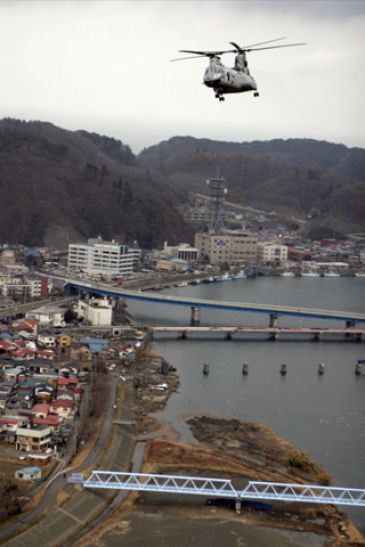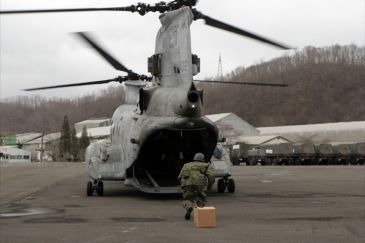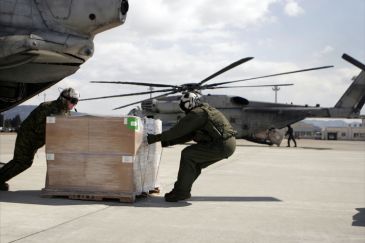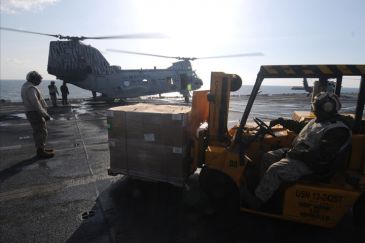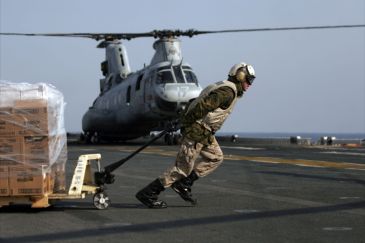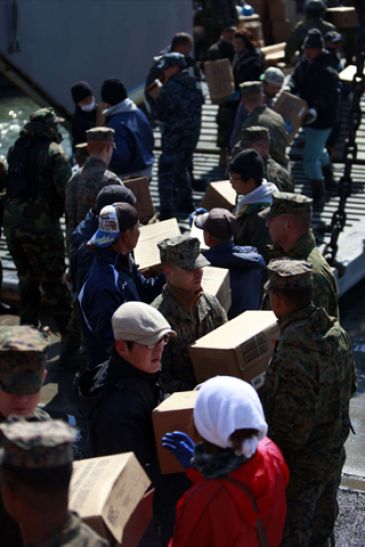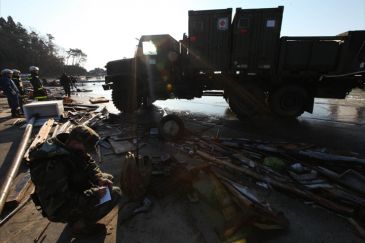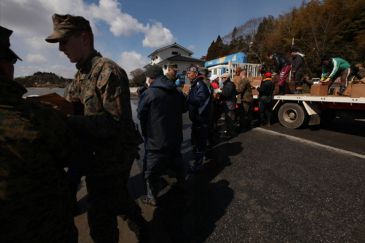A year pass, tsunami in US marines eyes and camera.
30, March 2012
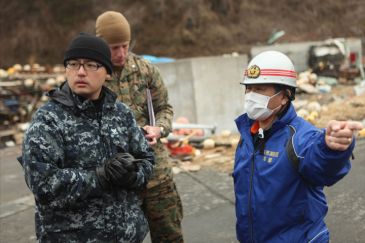
It’s been more than 1 year after the Tohoku earthquake had shaken Japan and the whole world over with huge wave of tsunami. More than 10,000 lives were lost while a lot more people had nowhere to return, the place they once called home will likely never be the same.
Among all efforts to help Japanese people during the earthquake and the aftermath, the US Marines, the 31st MEU which stationed at Okinawa, played the great part in transporting supply and helps to disconnected area. 31st MEU US Marines was also the very first unit alongside JSDF that reached the affected area. During operation Tomodachi (“friend” in Japanese language) they saw so many events, both life treasure and deep sorrow that could even describe in words. A year has passed and right now it’s time to talk with them, Capt Caleb Eames and Cpl. Garry Welch, the PAO and combat photographer whose eyes reflect and records the story…
Which part of affected area did you go to and what is your job at scene?
Capt. Eames: I went to Kessenuma City area, and also to Oshima Island. My job at the scene was to escort media who were watching our relief efforts and provide them information about what we were doing. I was also managing our internal coverage of the events. While we did this, we also helped with the debris removal and finding personal items for residents.
Cpl. Welch: We worked out of Oshima Island. I don’t remember exactly what day I arrived on the island, but I know I was there for about a week. My job was to document what was happening through the use of photographs and print stories about what the Marines and Sailors of the 31st Marine Expeditionary Unit were doing. I did that, and when I wasn’t photographing I was helping clear debris with them.
At the time you arrived what struck you first? What would you call the most critical moment on your first day?
Capt. Eames: The first day I was there I was struck by the enormity of the disaster. There was simply a huge amount of debris everywhere, it seemed as if nothing was left untouched. The thing that really I’ll never forget was going into the harbor area and seeing a huge ocean freighter hundreds of feet on shore, still tied to a concrete dock. It was resting on land where the tsunami left it. I’ll never forget that.
Cpl. Welch: When I arrived, what struck me first was just how devastated the area was. I didn’t realize that water could do so much damage. Where houses and businesses used to be, there were just the foundations left. The most critical moment on the first day would have to be when we delivered water to the people living in a school. They had treated the water of the city pool and had been drinking that because there was no other source of water. I think we delivered about 10,000 gallons of water that day. The other most critical thing that happened the first day was the delivery of electrical utility vehicles to the island so they could begin the process of restoring power to the citizens of the island. The trucks were brought to the island aboard Navy Landing Craft.
The picture you expected to see before getting into the area and the one appearing before your eyes when you arrived, were they different?
Cpl. Welch: I really can’t answer that question. I had no idea what to expect when I got to the island. We had been flying area surveillance missions for a few days all over the coast of Japan. So I knew it was going to be bad, but again, I had no way of knowing how bad it actually was.
Capt. Eames: The pictures and video simply don’t prepare one for seeing the scope of the damage up close. We knew there was going to be a big job to recover from the disaster, but being on the ground made me understand that it would take years to begin the recovery process. Also, being on the ground made it seem very personal. I saw child’s toys and clothes strewn throughout the debris – and I thought about my own children. When I got to Oshima, I realized that people’s lives had been affected and it wasn’t something distant any more, it became very personal.
As time went by, what hit you the hardest from the situation? (How)
Capt. Eames: As time went by the hardest part was leaving after the Japanese government said we had completed everything we needed to do. Everyone I was with would have liked to stay longer and help more, but we felt so honored to be able to help out for the time we did.
Cpl. Welch: I think what hit me the hardest was actually on the ride to the island. We were on the landing craft and I was looking over the side of it. There was lots of debris in the water, but at one point I saw a toddlers shoe float by. That made me realize that it wasn’t just houses that were destroyed, but also lives were lost.
With language barrier, how did you help the affected people and collaborated with the local working teams?
Capt. Eames: There was a bit of a language barrier, but we had Japanese Ground Self Defense Force officers assigned to us who helped us work through translations. We also communicated with the local fishermen with hand signals so that we understood each other. There was a particularly heavy piece of debris that the fisherman needed moved, so they gestured to us, and we understood and were able to move the debris. We also were able to move many fishing boats back to the harbor – they had been washed up into the city and the hills, and we were able to understand the fishermen who asked us with gestured to move their boat back to the water so they could begin their livelihoods again.
Cpl. Welch: We were able to get past the language barrier through the use of gestures. We kind of acted out what we meant and that usually conveyed what we were trying to tell the residents.
How was the atmosphere during that time? Especially the one among the rescuers and volunteers?
Capt. Eames: Among the rescuers and the volunteers there were times of sadness and there were times of laughter. People still found small things to smile about, but it was obvious many people were extremely sad as well. One time, I went up to a older couple sitting outside their house, at first, the woman smiled to see me, and then she came up to me and shook my hand. Then she started weeping uncontrollably for several minutes. I hugged her, told her that it was an honor to be helping and started crying too. It was very powerful moment when I realized the depth of hurt that these wonderful people had been through.
Cpl. Welch: Especially the one among the rescuers and volunteers? (Did they still laugh. Or did they easily feel sad. Were they emotional stable or being influenced by the situation, etc.) The atmosphere among the rescuers and volunteers was alright. When we first started clearing debris we were finding hundreds of photographs, and that made us think about the families, so that had us feeling sad, but as time went on and we saw the changes we were making the mood improved. What really helped was seeing how appreciative the people were of what we were doing. That made all of us feel really good, and like we were really making a difference in their lives.
What could make people laugh in daily life during the time? Both on the sides of affected people and the rescuer-volunteer team.
Capt. Eames: Often people would smile when they saw us Marines there for the first time. I went to ask some questions of a family who was picking through the debris of their former home, and they all smiled and laughed when I couldn’t speak Japanese. Then when they started thanking us for coming, they started crying. For the Marines, it was very somber, but we still found happiness in the people who were there working to recover from the disaster. Many of them had lost everything, yet they still came up to us with rice balls or candy and offered it to us. How amazing that they lost all, yet still wanted to give to us.
Cpl. Welch: Both on the sides of affected people and the rescuer-volunteer team. Well, for the Marines and Sailors it was just normal joking around, telling old stories as we worked. I really didn’t see many natives of Oshima Island laughing during our time there.
It’s been a year, are there anything from the site left in your mind until today?
Capt. Eames: Yes, I will remember all of the events on Oshima Island clearly for the rest of my life – it made such a big impression on me. I’ll always remember seeing the ocean ferry washed ashore in the town.
I remember a small American flag that was planted on a pile of debris in front of a house. The family had an American exchange student years ago, and wanted to thank the US Marines for coming, so they put the American flag up. When I saw that I felt very humbled.
I’ll also remember helping a 10 year old boy clean the remains of his house and help him recover his families personal items.
And I’ll always remember the woman who hugged me and cried.
Cpl. Welch: All of it, you don’t forget something like that. I talked with Marines who had fought in Iraq and Afghanistan who hadn’t seen devastation like that.
(All pictures are courtesy of the 31st MEU.)
